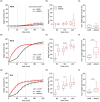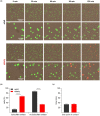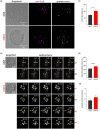Faster cytotoxicity with age: Increased perforin and granzyme levels in cytotoxic CD8+ T cells boost cancer cell elimination
- PMID: 35818124
- PMCID: PMC9381916
- DOI: 10.1111/acel.13668
Faster cytotoxicity with age: Increased perforin and granzyme levels in cytotoxic CD8+ T cells boost cancer cell elimination
Abstract
A variety of intrinsic and extrinsic factors contribute to the altered efficiency of CTLs in elderly organisms. In particular, the efficacy of antiviral CD8+ T cells responses in the elderly has come back into focus since the COVID-19 pandemic outbreak. However, the exact molecular mechanisms leading to alterations in T cell function and the origin of the observed impairments have not been fully explored. Therefore, we investigated whether intrinsic changes affect the cytotoxic ability of CD8+ T cells in aging. We focused on the different subpopulations and time-resolved quantification of cytotoxicity during tumor cell elimination. We report a surprising result: Killing kinetics of CD8+ T cells from elderly mice are much faster than those of CD8+ T cells from adult mice. This is true not only in the total CD8+ T cell population but also for their effector (TEM ) and central memory (TCM ) T cell subpopulations. TIRF experiments reveal that CD8+ T cells from elderly mice possess comparable numbers of fusion events per cell, but significantly increased numbers of cells with granule fusion. Analysis of the cytotoxic granule (CG) content shows significantly increased perforin and granzyme levels and turns CD8+ T cells of elderly mice into very efficient killers. This highlights the importance of distinguishing between cell-intrinsic alterations and microenvironmental changes in elderly individuals. Our results also stress the importance of analyzing the dynamics of CTL cytotoxicity against cancer cells because, with a simple endpoint lysis analysis, cytotoxic differences could have easily been overlooked.
Keywords: CD8+ T cells; CTL; aging; cytotoxicity; granzyme; immunosenescence; perforin; tumor immunology.
© 2022 The Authors. Aging Cell published by Anatomical Society and John Wiley & Sons Ltd.
Conflict of interest statement
Authors declare that they have no competing interests.
Figures






Similar articles
-
Single-cell perforin and granzyme expression reveals the anatomical localization of effector CD8+ T cells in influenza virus-infected mice.Proc Natl Acad Sci U S A. 2003 Mar 4;100(5):2657-62. doi: 10.1073/pnas.0538056100. Epub 2003 Feb 24. Proc Natl Acad Sci U S A. 2003. PMID: 12601154 Free PMC article.
-
Granule exocytosis, and not the fas/fas ligand system, is the main pathway of cytotoxicity mediated by alloantigen-specific CD4(+) as well as CD8(+) cytotoxic T lymphocytes in humans.Blood. 2000 Apr 1;95(7):2352-5. Blood. 2000. PMID: 10733506
-
Serial killing by cytotoxic T lymphocytes: T cell receptor triggers degranulation, re-filling of the lytic granules and secretion of lytic proteins via a non-granule pathway.Eur J Immunol. 1995 Apr;25(4):1071-9. doi: 10.1002/eji.1830250432. Eur J Immunol. 1995. PMID: 7737276
-
Fas- and perforin-independent mechanism of cytotoxic T lymphocyte.Immunol Res. 1998;17(1-2):89-93. doi: 10.1007/BF02786434. Immunol Res. 1998. PMID: 9479571 Review.
-
PELs and the perforin and granzyme independent mechanism of CTL-mediated lysis.Immunol Rev. 1995 Aug;146:21-31. doi: 10.1111/j.1600-065x.1995.tb00681.x. Immunol Rev. 1995. PMID: 7493754 Review.
Cited by
-
Effects of PACAP Deficiency on Immune Dysfunction and Peyer's Patch Integrity in Adult Mice.Int J Mol Sci. 2024 Oct 3;25(19):10676. doi: 10.3390/ijms251910676. Int J Mol Sci. 2024. PMID: 39409005 Free PMC article.
-
Mesothelin- and nucleolin-specific T cells from combined short peptides effectively kill triple-negative breast cancer cells.BMC Med. 2024 Sep 18;22(1):400. doi: 10.1186/s12916-024-03625-3. BMC Med. 2024. PMID: 39294656 Free PMC article.
-
In vivo labeling reveals that degranulation is increased under supraphysiological TCR stimulation, but not infection, in CD8+ T cells from old mice.Geroscience. 2025 Jun 6. doi: 10.1007/s11357-025-01723-5. Online ahead of print. Geroscience. 2025. PMID: 40478430
-
Intranasal Immunization With Nanoparticles Containing an Orientia tsutsugamushi Protein Vaccine Candidate and a Polysorbitol Transporter Adjuvant Enhances Both Humoral and Cellular Immune Responses.Immune Netw. 2023 Dec 15;23(6):e47. doi: 10.4110/in.2023.23.e47. eCollection 2023 Dec. Immune Netw. 2023. PMID: 38188601 Free PMC article.
-
Heterozygous OT-I mice reveal that antigen-specific CD8+ T cells shift from apoptotic to necrotic killers in the elderly.Aging Cell. 2023 Jun;22(6):e13824. doi: 10.1111/acel.13824. Epub 2023 Mar 22. Aging Cell. 2023. PMID: 36947105 Free PMC article.
References
-
- Aggarwal, S. , & Gupta, S. (1998). Increased apoptosis of T cell subsets in aging humans: altered expression of Fas (CD95), Fas ligand, Bcl‐2, and Bax. [Comparative Study]. Journal of Immunology, 160(4), 1627–1637. - PubMed
-
- Backes, C. S. , Friedmann, K. S. , Mang, S. , Knorck, A. , Hoth, M. , & Kummerow, C. (2018). Natural killer cells induce distinct modes of cancer cell death: Discrimination, quantification, and modulation of apoptosis, necrosis, and mixed forms. [Research Support, Non‐U.S. Gov't]. The Journal of Biological Chemistry, 293(42), 16348–16363. 10.1074/jbc.RA118.004549 - DOI - PMC - PubMed
-
- Betts, M. R. , Brenchley, J. M. , Price, D. A. , De Rosa, S. C. , Douek, D. C. , Roederer, M. , & Koup, R. A. (2003). Sensitive and viable identification of antigen‐specific CD8+ T cells by a flow cytometric assay for degranulation. Journal of Immunological Methods, 281(1–2), 65–78. 10.1016/s0022-1759(03)00265-5 - DOI - PubMed
-
- Contreras, A. , Beems, M. V. , Tatar, A. J. , Sen, S. , Srinand, P. , Suresh, M. , Luther, T. K. , & Cho, C. S. (2018). Cotransfer of tumor‐specific effector and memory CD8+ T cells enhances the efficacy of adoptive melanoma immunotherapy in a mouse model. [Research Support, N.I.H., Extramural Research Support, U.S. Gov't, Non‐P.H.S.]. Journal for Immunotherapy of Cancer, 6(1), 41. 10.1186/s40425-018-0358-2 - DOI - PMC - PubMed
Publication types
MeSH terms
Substances
LinkOut - more resources
Full Text Sources
Medical
Research Materials

